The ‘Wild Man of the Woods’ and ‘the Hunting of the Earl of Rone’: Tyrone in English folk tradition
Published in Early Modern History (1500–1700), Issue 4 (Jul/Aug 2007), News, Volume 15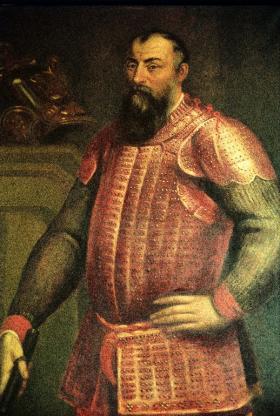
Hugh O’Neill—echoes of his rebellion preserved in English folklore. (Lord Dunsany)
English folklore appears to preserve echoes of the rebellion of Hugh O’Neill in the story of the ‘Wild Man of the Woods’ and the Devon custom of ‘the Hunting of the Earl of Rone’. The first story has O’Neill in hiding in 1603—not in the forest of Glenconkeyne in Ulster but in Lancashire. It was written down and plainly much embellished in John Roby’s Traditions of Lancashire (2 vols, Manchester, 1872), I, 220–46:
‘The following narrative, floating but indistinctly on the author’s memory, and in all probability attached to other names in localities widely apart, is yet, he believes, true as to the more important particulars. The site of a few cottages in a romantic dell in the neighbourhood of Rochdale is still associated with the memory of the unfortunate Earl of Tyrone. It is yet called “Tyrone’s Bed”.
A stranger had been lurking for about three months in a forested area near Gristlehurst Hall, the home of the Holt family, and locals had identified him with the wild man of the woods. The mysterious stranger really came to local attention when dressed in a grey cloak and coarse felt cap when he rescued Constance Holt, the daughter of the big house, from drowning and revived her on the river bank. This is presumably the site known in the folklore as “Tyrone’s Bed”.
The stranger later turned up at the house and disclosed his identity to Constance. “Maiden, I am pursued. The foe are on my track. My retreat is discovered, and unless thou wilt vouchsafe to me a hiding-place, I am in their power. The Earl of Tyrone—nay, I scorn the title—’tis the King of Ulster that stands before thee. I would not crouch thus for my life, were it not for my country. Her stay, her sustenance, is in thy keeping.” Unbeknownst to her ostensibly loyalist father, Constance hid the stranger in a secret room in the house. He wanted to move on as the area had become unsafe. However he turned up again soon afterwards exclaiming that the hounds were on his heels and that in all likelihood an armed posse led by the sheriff was on its way. This time she hid the earl in a concealed place in her own room. When the sheriff arrived with a warrant, he insisted on searching everywhere. He finally found the secret door behind her bed and entered it but Tyrone escaped after tying up and gagging the lawman. Later after he had gained his pardon, Tyrone turned up again this time to see Constance, her love unrequited, on her death-bed.’
This never happened, of course, and obviously the story has been greatly amplified and romanticised in the retelling. Yet it cannot be dismissed out of hand entirely. What it seems to indicate is the sneaking regard that some English Catholic recusants may have had for the exploits of the earl of Tyrone. They were subject at this time to tougher penal laws than Irish Catholics, and there were suspicions about their loyalty to the crown. Tyrone had English seminary priests in his entourage, and government spies and informers amongst the English recusant community picked up reactions to events in Ireland. In 1600 Miler Magrath reported at the height of O’Neill’s power that
‘Here and there Tyrone maketh great brags and promises by his letters of invasion and troubles as well to be shortly in Ireland as in England, dreaming the seminaries to be able to remove mountains and that which is more heaven and hell, in which points they deceive very many’.
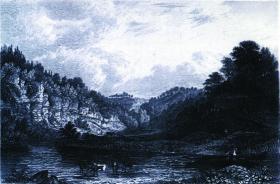
‘Tyrone’s Bed’ near Rochdale, Lancashire.
Lancashire was a hotbed of English recusancy—the Holts were amongst their number, and William Holt (d. 1599) was one of the leaders of the Jesuit mission to England. Local officials indicated reluctance on the part of the county’s recusants to pay contributions towards the war in Ireland, and the bishop of Chester claimed that the Catholics in his diocese ‘have been encouraged by our ill success in Ireland’. The government had also picked up rumours from Wales of O’Neill’s impact there. Amongst the Welsh his resistance seems to have struck a nationalist cord. Some thought that his title of Tyrone meant that ‘he descended of Owyne Clyne Dore, who had interest both in Ireland and Wales and that there was a prophecy that the Earl of Tyrone should prevail against English action’. It was believed that he paid Welsh soldiers who joined his service more than he did his own countrymen, and that he was soon expected to mount an invasion of Wales with Spanish support.
Such positive feelings about Hugh O’Neill were those of a small minority, of course, because the predominant popular attitude was one of fear and revulsion. This was vividly portrayed by the stones and dirt thrown at the earl when, following his surrender, he travelled from Beaumaris to London in early June 1603 in the company of Lord Deputy Mountjoy. Most of these assailants were wives and mothers who had lost husbands and sons in the Irish war, and when he reached London the authorities felt the need to issue a proclamation that O’Neill, having expressed sorrow for his former offences and having been re-admitted to royal favour, was not to be abused. Nevertheless, further precautions were taken to have him guarded and convoyed by local sheriffs as he returned home the following September. It is hard to ascertain how many English and Welsh men had lost their lives in the war to subdue him and his confederates. A conservative estimate would be that a third of the c. 25,000 who served there did not return, but half might be equally plausible. Tyrone himself was not the main killer. Battlefield casualties were relatively light, but camp diseases such as typhoid and dysentery took an enormous toll. Furthermore, those who did return either as deserters at the time or as wounded men later on became vagabonds and cripples dependent on parish relief. Indeed, the financial strain of the war had been enormous. Secretary Cecil reckoned that the Irish war cost nearly £2,000,000—more than the Armada campaign and the Dutch intervention put together. A distinct war-weariness had already set in by the time of Essex’s débâcle in 1599. By 1601–2 it wasn’t only the recusants who were reluctant to pay. Increased tax demands were not being fully answered, City of London merchants were becoming distinctly unhappy about being subjected to forced loans, and the shires were beginning to buckle under the levies required to fit out troops. In the light of these facts it is clear that the other echo of Tyrone in English folklore—this time a Devon folk custom—reflects a far more widespread negative memory of him.
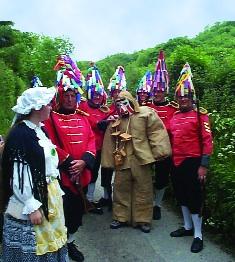
‘Hunting the Earl of Rone’ (the figure dressed in brown) in Combe Martin, north Devon. (Tom and Barbara Brown)
‘The Hunting of the Earl of Rone’, in the village of Combe Martin in north Devon, was originally a series of processions and festivities that took place in the fortnight running up to Ascension Day. The custom died out or was suppressed in 1837 because of the attendant drinking and brawling, but was revived in 1974 and now takes place over the UK Spring Bank Holiday weekend. It involves parades each day from Friday to Monday. The first involves a large, round-shaped hobby horse attended by a fool and a squadron of grenadiers. Saturday has a procession of local children that climaxes in the eating of a large strawberry sponge cake. On Sunday there is a fuller and more extended version of the Friday parade. On Monday another parade leads to the Earl of Rone being captured in a nearby wood and brought into the village mounted back to front on a donkey. The humiliated figure on the donkey, dressed in sackcloth with a string of sea-biscuits round his neck, is repeatedly shot, killed, revived and remounted as the procession moves towards the village beach, where his dead body is cast into the sea. What all this signifies is not absolutely clear. Obviously there is a pagan ‘wild man of the woods’ element here, as well as the resonances of the Catholic Stations of the Cross surviving from the Middle Ages. Most of those who have studied the Combe Martin festivities, however, including Tom Brown, who wrote an informative pamphlet about the event in 1997, agree that the Earl of Rone can be none other than Hugh O’Neill, second earl of Tyrone. There is simply no other obvious candidate.
The Combe Martin festivities seem to preserve memories of not only Tyrone’s time in the woods of Glenconkeyne but also the Flight of the Earls itself. The West Country was a big recruiting ground for soldiers who fought in the Nine Years’ War. Not only were many of the rank and file locals but so too were the officer corps and field commanders. After the war Mountjoy was made earl of Devonshire and Sir George Carew, his lieutenant in Munster, was made earl of Totnes. Sir Arthur Chichester, who as commander of crown forces in east Ulster was closely involved in the hunt for O’Neill in the forest of Glenconkeyne in the winter of 1602–3, came from Raleigh in north Devon. At nearby Pilton Church his brother, Sir Robert, who died two years after him, had a funerary monument built every bit as elaborate as the one that Chichester commissioned for himself in Carrickfergus. Furthermore, Chichester had succeeded Mountjoy and was chief governor of Ireland at the time of the Flight of the Earls in 1607.
Nor did the Flight of the Earls pass unnoticed in Devon itself. At first no one in Ireland or England knew where the earls and their entourage had ended up. At the start of October rumours reached London that the earl had landed in Wales, and Lord Sheffield wrote from York that the earl’s sudden departure had ‘struck in these parts a great
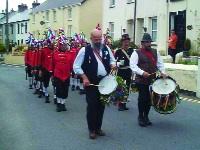
fear’. Even though it soon became clear that Tyrone’s ship had reached France, it was decided to rush 800 soldiers to Ireland as an emergency security measure. One hundred of these—‘lusty tall fellowes voluntaries and idle persons craving employment in that service’—were raised in Devon on government orders by the earl of Bath and shipped out from Barnstaple on 15 November 1607, as had so often happened during the Nine Years’ War itself. Given these local connections with the war in Ireland, it is altogether possible that local people would have made the earl of Tyrone part of their Ascension Day folk customs, especially after the religious aspects had been toned down by the Reformation.
Ireland continued to be in the news for most of the seventeenth century. The country and its people were believed to constitute a threat. The civil war raised possibilities of an Irish intervention to support Charles I. Later in the century there was the Popish Plot (1679–81) and ‘the Irish Fright’—a mass panic in December 1688, when it was rumoured that Dick Talbot’s re-Catholicised Irish army was on its way to bail out James II’s crumbling regime. Indeed, local legend relates the earl’s shipwreck ‘at a small beach between Ilfracombe and Combe Martin which is to this day called Raparee Cove’ (Brown 1997, 12).
Brown in his Hunting of the Earl of Rone pamphlet associates both his own Combe Martin tradition and the Lancashire story as examples of the earl of Tyrone’s story being grafted onto the ancient Wild Man of the Woods legend. Either way, it is surely ironic that there should be more folk memory of the earl of Tyrone in England than in Ireland. On the other hand, the former was not subject in the early modern period to such a violent rupture with its past—namely massive conquest, colonisation and persecution.
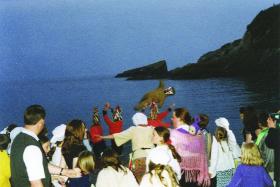
Hiram Morgan lectures in history at University College Cork.
















